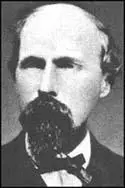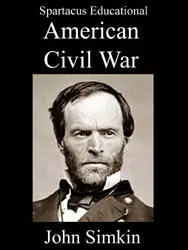Samuel Mudd

Samuel Mudd was born in Charles County, Maryland, on 20th December, 1833. The son of a large plantation owner, Henry Lowe Mudd, he attended Georgetown College before studying medicine at the University of Maryland.
After graduation in 1856 Mudd returned to Charles County where he worked as a doctor before marrying Sarah Dyer and buying his own farm at Bryantown, Maryland.
Mudd, an advocate of slavery, was a supporter of the Confederacy during the American Civil War. He also associated with agents working for the Confederate Army. This included John Wilkes Booth, who he met for the first time on 13th November, 1864. Further meetings took place between the two men and Louis Weichmann saw him with Booth and John Surratt talking together in Washington on 23rd December, 1864.
After John Wilkes Booth shot Abraham Lincoln on 14th April, 1865 he and David Herold arrived at Mudd's house the following day. Mudd set, splinted and bandaged Booth's broken leg. Mudd also arranged for a carpenter to make Booth a pair of crutches.
The detectives investigating Lincoln's murder soon discovered that Mudd had treated John Wilkes Booth while on the run from the authorities. Mudd was arrested and charged with conspiracy to murder Abraham Lincoln. During his trial Mudd denied recognizing Booth when he treated him. Evidence was also provided that Mudd had a record of bad behaviour towards slaves. This included the shooting of one of his men for disobedience.
On 1st May, 1865, President Andrew Johnson ordered the formation of a nine-man military commission to try the conspirators. It was argued by Edwin M. Stanton, the Secretary of War, that the men should be tried by a military court as Lincoln had been Commander in Chief of the army. Several members of the cabinet, including Gideon Welles (Secretary of the Navy), Edward Bates (Attorney General), Orville H. Browning (Secretary of the Interior), and Henry McCulloch (Secretary of the Treasury), disapproved, preferring a civil trial. However, James Speed, the Attorney General, agreed with Stanton and therefore the defendants did not enjoy the advantages of a jury trial.
The trial began on 10th May, 1865. The military commission included leading generals such as David Hunter, Lewis Wallace, Thomas Harris and Alvin Howe and Joseph Holt was the government's chief prosecutor. Mary Surratt, Lewis Powell, George Atzerodt, David Herold, Samuel Mudd, Michael O'Laughlin, Edman Spangler and Samuel Arnold were all charged with conspiring to murder Lincoln. During the trial Holt attempted to persuade the military commission that Jefferson Davis and the Confederate government had been involved in conspiracy.
Joseph Holt attempted to obscure the fact that there were two plots: the first to kidnap and the second to assassinate. It was important for the prosecution not to reveal the existence of a diary taken from the body of John Wilkes Booth. The diary made it clear that the assassination plan dated from 14th April. The defence surprisingly did not call for Booth's diary to be produced in court.
On 29th June, 1865, Mudd was found guilty of conspiracy to murder. He missed the death penalty by one vote and was sentenced to life imprisonment. Mary Surratt, Lewis Powell, George Atzerodt and David Herold were hanged at Washington Penitentiary on 7th July, 1865. Mudd, along with Michael O'Laughlin, Edman Spangler and Samuel Arnold were imprisoned at Fort Jefferson.
In December, 1865, Mudd complained to his wife about being guarded by black soldiers who he described as being a "set of ignorant, prejudiced and irresponsible beings of the unbleached humanity". Mrs. Mudd passed these comments onto President Andrew Johnson who responded by ordering better treatment for Mudd and his fellow conspirators at Fort Jefferson.
During an outbreak of yellow fever in 1867, the prison doctor died. Mudd agreed to take over and although coming down with the disease he recovered. One of his fellow conspirators, Michael O'Laughlin, was less fortunate and died from the disease.
Mudd was pardoned by Andrew Johnson on 1st March, 1869. He returned home, taking with him Edman Spangler, who he gave 5 acres of land. In 1876 Mudd was elected to the Maryland legislature. Samuel Mudd died of pneumonia on 10th January, 1883.
Primary Sources
(1) Samuel Mudd, statement presented at his trial (13th May, 1865)
We (Mudd and Booth) started down one street, and then up another, and had not gone far when we met Surratt and Weichmann. Introductions took place and we turned back in the direction of the hotel. After arriving in the room, I took the first opportunity presented to apologize to Surratt for having introduced him to Booth - a man I knew so little concerning. This conversation took place in the passage in front of the room (hallway) and was not over three minutes in duration. Surratt and myself returned and resumed our former seats (after taking drinks ordered) around a center table, which stood midway the room and distant seven or eight feet from Booth and Weichmann; Booth remarked that he had been down to the country a few days before, and said that he had not yet recovered from the fatigue. Afterward he said he had been down in Charles County, and had made me an offer to purchase of my land, which I confirmed by an affirmative answer; and he further remarked that on his way up (to Washington) he lost his way and rode several miles off the track.
(2) Lieutenant Alexander Lovett, testimony at Dr. Mudd's trial (16th May, 1865)
On the day after the assassination of the President, I went with others in pursuit of the murderers. We went by way of Surrattsville to the house of Dr. Samuel A. Mudd, which is about thirty miles from Washington. Dr. Mudd did not at first seem inclined to give us any satisfaction; afterward he went on to state that on Saturday morning, at daybreak, two strangers had come to his place; one of them rapped at the door, the other remained on his horse. Mudd went down and opened the door, and with the aid of the young man who had knocked at the door helped the other, who had his leg broken, off his horse, took him into his house and set his leg. On asking him who the man with the broken leg was, he said he did not know; he was a stranger to him.
(3) Thomas Ewing, Samuel Mudd's attorney, was interviewed about the case by George Alfred Townsend in 1883.
The court very nearly hanged Dr. Mudd. His prevarication's were painful. He had given his whole case away by not trusting even his counsel or neighbors or kinfolk. It was a terrible thing to extricate him from the toils he had woven about himself. He had denied knowing Booth when he knew him well. He was undoubtedly accessory to the abduction plot, though he may have supposed it would never come to anything. He denied knowing Booth when he came to his house when that was preposterous. He had been even intimate with Booth.
(4) Edward Steers Jnr., The Deceptive Doctor , Columbiad Magazine (Winter, 2000)
During his initial interview with investigating detectives on April 18, 1865, Dr. Samuel A. Mudd claimed, "I never saw either of the parties before, nor can I conceive who sent them to my house."1 With these words Dr. Mudd told the first in a series of lies about his involvement with John Wilkes Booth and Booth's conspiracy to capture President Abraham Lincoln, a conspiracy that would ultimately lead to Lincoln's assassination at Ford's Theatre.
In statements given prior to his arrest, Mudd lied about virtually every piece of information the authorities were seeking in their effort to capture Booth. Lieutenant Alexander Lovett, the first interrogator, and Colonel Henry H. Wells, the second interrogator, both complained of the doctor's evasiveness and apparent untruthfulness during their questioning of him.26 This behavior led Wells to place Mudd under arrest and send him to Washington under guard.
Mudd's attempt to convince the military authorities that he had only met with Booth on one occasion belies all of the facts in his case. Mudd withheld even from his own attorneys information about the meeting at the National Hotel, where he had introduced Booth to Surratt, and the December meeting in Bryantown with Harbin. Ignorant of both meetings, Maj. Gen. Thomas Ewing, one of Mudd's two defense attorneys, weakened his credibility with the military commission by arguing that Weichmann had lied about the hotel meeting in late December and that Mudd had only "met Booth before the assassination but once on Sunday, and once the day following, in November last."27 The commission believed differently.
After his conviction Mudd and co-conspirators Michael O'Laughlin, Samuel Arnold, and Edman Spangler were transported to Fort Jefferson, where the men were scheduled to serve out their prison sentences. During the trip they were placed under a military guard commanded by Captain George W. Dutton. Captain Dutton later claimed that during the journey Mudd had "confessed that he knew Booth when he came to his house with Herold on the morning after the assassination of the President." The captain said that Mudd "also confessed that he was with Booth at the National Hotel on the day referred to by Weichmann in his testimony; and that he came to Washington on that occasion to meet Booth by appointment who wished to be introduced to John Surratt."
History has been much kinder to Mudd than the events in the assassination should warrant. The facts that have emerged about his involvement with Booth belie the popular image of Mudd as a gentle country doctor who unexpectedly became entangled in a tragic murder through no fault of his own. The current perception of an innocent Dr. Mudd is largely due to the tireless efforts of Dr. Richard Dyer Mudd, who has struggled for seventy years to clear his grandfather's name and officially expunge the findings of the military tribunal that convicted him. His efforts have come close to fruition in the past decade.

